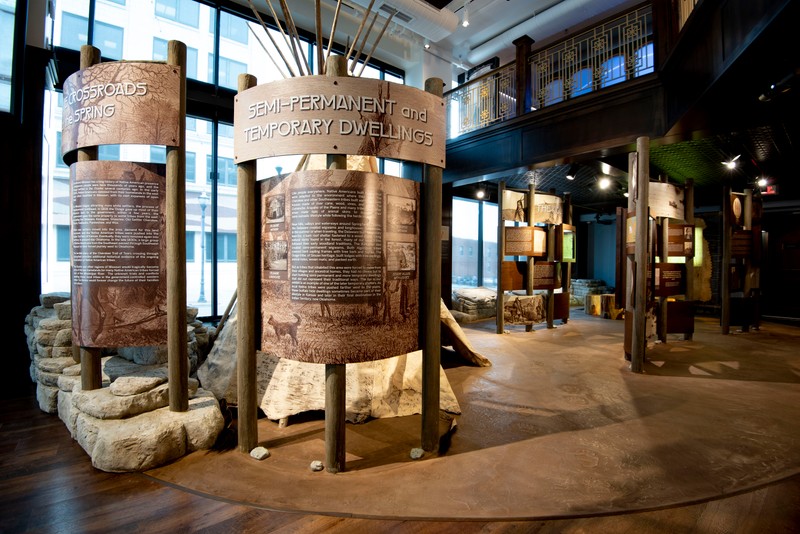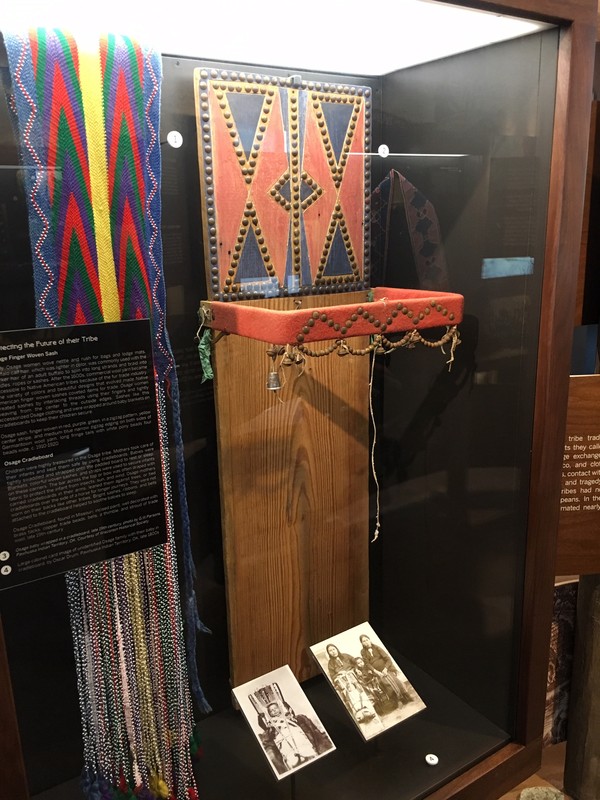Native Crossroads at the Spring Gallery
Introduction
Text-to-speech Audio
Images
Native Crossroads at the Springs


Osage Finger Woven Sash and Cradleboard

Backstory and Context
Text-to-speech Audio
The story of Native Americans in Springfield is a story of movement. Many tribes have passed through the area, staying for a few or many decades and ultimately moving on either voluntarily or by force.
The Osage came from the Ohio River Valley over 1000 years ago. They have spent the longest time in Missouri. They were known to be strong, tall, and a dominant culture. They created villages where they grew corn, beans, and squash. Twice a year, they went on long distance buffalo hunting trips. They used Springfield for hunting and trading first by setting up camps and then making those into villages. Half the population died from the introduction of European diseases. In 1808, 52 million acres of land were ceded to the government and the Osage moved to Kansas and later on Oklahoma.
The Delaware, or Lenape, originated near the Delaware River in New York State. They were the first to sign a treaty with the newly formed United States. Forced to cede their land, they moved to Ohio and Indiana and then near the James River. White traders continued to move with them and eventually forced them out of Missouri and in to Kansas and Oklahoma.
The Kickapoo were living near the Great Lakes and had moved to Indian and Illinois. Following their participation in the Iroquoi Convention battles, they were forced to move to Missouri. Their largest village of 100 wickiups was built south of Springfield’s Square. After issues with the Osage and white settlers, they petitioned the government to move to Kansas.
About16,000 Cherokee were forcibly removed from the southeast of the US in the 1830s and relocated in Oklahoma. Several thousand died along the way. Two of the routes passed through Springfield.
Below is highlight a few of the items that can be found in this gallery.
- Osage Finger Woven Sash - Early Osage women wove nettle and rush for bags and lodge mats. Buffalo calf hair, which was lighter in color, was commonly used with the darker hair of an adult buffalo to spin into long strand and braid into bridles, ropes and sashes. After the 1600s, commercial wool yarn became accessible to Native American tribes because of the fur trade industry. The variety of colors and beautiful designs that evolved made Native American finger woven sashes coveted items for trade. Osage women created sashes by interlacing threads using their fingers and tightly weaving them from the center to the outside edges. Sashes like this accessorized Osage clothing and were wrapped around baby blankets on cradleboards to keep their children secure.
- Osage Cradleboard - Mothers in the Osage tribe took care of their infants and kept them safe using cradleboards. Babies were tightly swaddled and strapped onto the padded board to rest or sleep. Blankets, colorful woven sashes, and straps were used to secure infants on these carriers. The bar across the top or bow was often draped with fabric to protect the infant from insects, sun, and wind. Osage mothers carried cradleboards in their arms, leaned them against trees, or tied them over the side of a horse for longer journeys. They were not worn on their backs like other tribes. Bright sashes, ribbons, and bells attached to the cradleboard helped to soothe babies to sleep.
